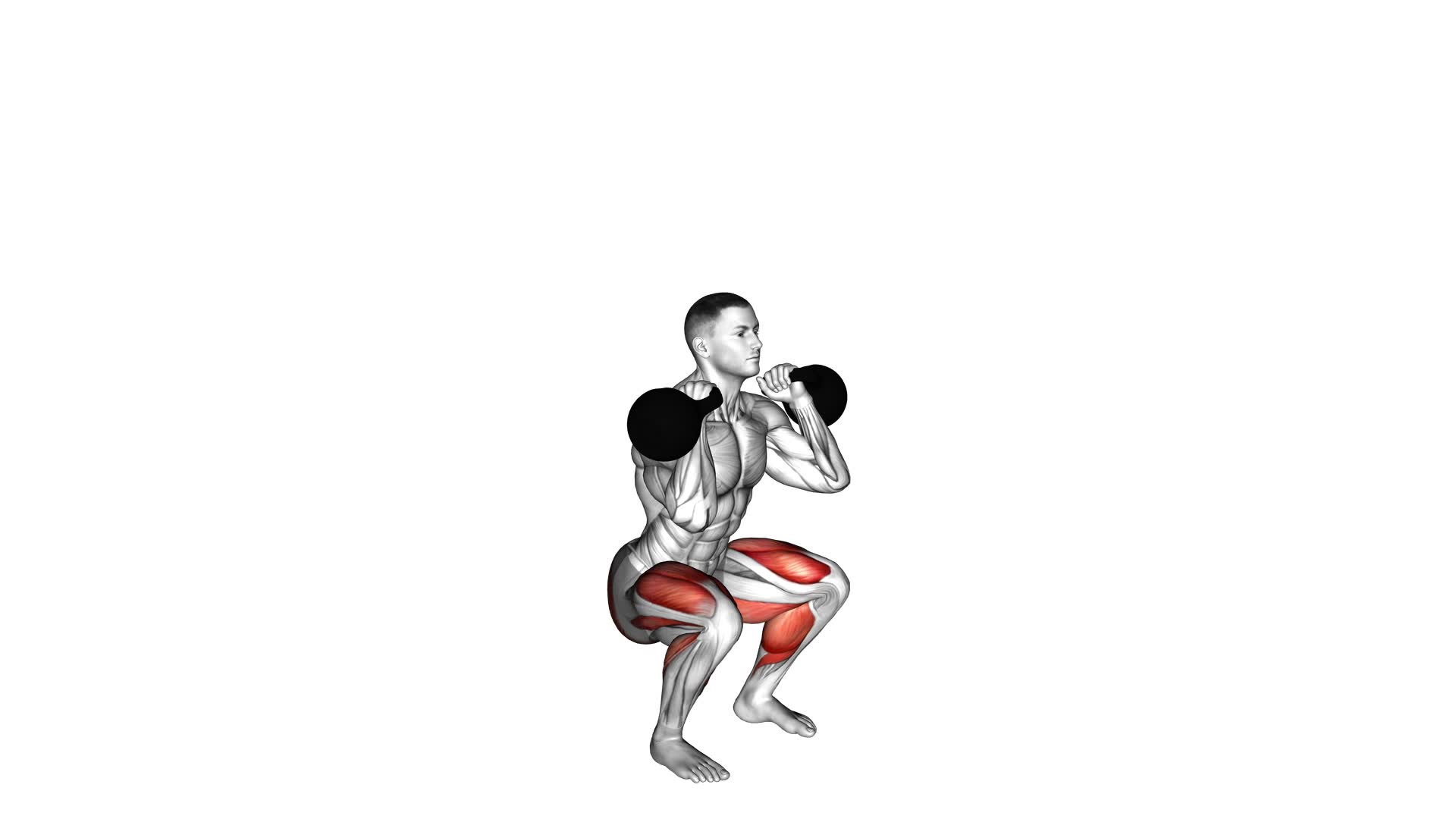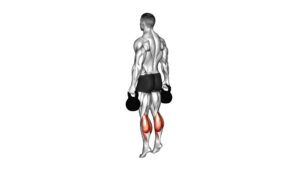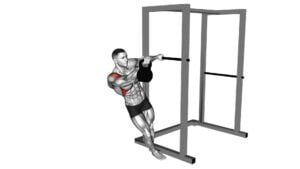Kettlebell Calf Raise and Front Squat (male) – Video Exercise Guide & Tips

In this video exercise guide, you'll learn how to perform the kettlebell calf raise and front squat with proper form and technique. This dynamic duo of exercises targets your calf muscles and strengthens your lower body.
Watch This Exercise Video
Follow along for step-by-step instructions and valuable tips on maximizing your results. Avoid common mistakes and get the most out of your kettlebell leg workouts.
Get ready to feel the burn and build strength with these challenging exercises. Let's get started!
Key Takeaways
- Kettlebell calf raise and front squat exercises strengthen calf muscles and provide variation to traditional squats.
- These exercises improve lower body stability and explosiveness, target quadriceps and core muscles, and enhance core stability and overall balance.
- Proper form and technique are important for kettlebell calf raise and front squat exercises to maximize results and avoid common mistakes.
- Regular exercise routine, adding variety to workouts, proper warm-up and cool-down, strength training, and proper nutrition are all important factors for overall fitness and optimal exercise performance.
Benefits of Kettlebell Calf Raise and Front Squat
You will experience numerous benefits from incorporating the kettlebell calf raise and front squat into your workout routine. These exercises are highly effective in strengthening your calf muscles and provide a great variation to traditional squats.
The calf raise with kettlebell is a targeted exercise that specifically focuses on your calf muscles. By standing on the edge of a step or a raised platform with your heels hanging off, and holding a kettlebell in your hands, you can perform calf raises by raising your heels as high as possible and then lowering them back down. This exercise helps to build strength and endurance in your calf muscles, improving your overall lower body stability and explosiveness.
On the other hand, the front squat with kettlebell is a squat variation that places more emphasis on your quadriceps and core muscles. By holding a kettlebell in front of your chest, with your elbows tucked in and your feet shoulder-width apart, you can perform a squat by lowering your hips down and then pushing through your heels to return to the starting position. This exercise not only strengthens your lower body, but also enhances your core stability and overall balance.
Incorporating the kettlebell calf raise and front squat into your workout routine will help you to develop stronger and more defined calf muscles, while also improving your overall lower body strength and stability.
Now, let's move on to the next section where we'll discuss the proper form and technique for the kettlebell calf raise.
Proper Form and Technique for Kettlebell Calf Raise
To perform the kettlebell calf raise with proper form and technique, focus on maintaining a stable stance and engaging your calf muscles throughout the exercise. Here are some tips to help you perform the kettlebell calf raise correctly:
- Start by standing with your feet shoulder-width apart and your toes pointing forward.
- Hold a kettlebell in each hand, allowing your arms to hang naturally by your sides.
- Keeping your core engaged and your back straight, rise up onto your toes as high as possible.
- Pause for a moment at the top, squeezing your calf muscles.
- Slowly lower your heels back down to the starting position.
By following these guidelines, you can ensure that you're performing the kettlebell calf raise effectively and maximizing the benefits for your calf muscles. Remember to start with lighter weights and gradually increase as you become more comfortable with the exercise.
Now that you have learned the proper form and technique for the kettlebell calf raise, let's move on to the next section, which will provide a step-by-step guide for the kettlebell front squat.
Step-By-Step Guide for Front Squat With Kettlebell
The next exercise to focus on is the front squat with kettlebell, which will further strengthen your lower body muscles. The front squat is a variation of the traditional squat that places more emphasis on the quadriceps and core muscles. Adding a kettlebell to the front squat adds an extra challenge and benefits your overall strength and stability.
To perform the kettlebell front squat, start by holding the kettlebell in front of your chest with both hands, elbows bent and close to your body. Stand with your feet shoulder-width apart and toes slightly turned out. Keep your core engaged and chest lifted throughout the movement.
Next, initiate the squat by bending at the hips and knees, lowering your body towards the ground. Keep your weight in your heels and maintain a neutral spine. As you descend, aim to bring your thighs parallel to the ground or slightly below.
Push through your heels and engage your glutes to return to the starting position. Keep your chest lifted and maintain control throughout the movement.
The front squat with kettlebell offers several benefits, including increased lower body strength, improved core stability, and enhanced balance and coordination. Incorporating front squat variations into your workout routine can help you target different muscle groups and keep your workouts challenging and effective.
Tips for Maximizing Results With Kettlebell Exercises
For optimal results with kettlebell exercises, focus on proper form and technique. Here are some tips to help you maximize your results while improving stability and increasing strength:
- Start with a lighter kettlebell: When starting out, it's important to choose a kettlebell that you can handle comfortably. This will allow you to focus on your form and technique without sacrificing stability.
- Engage your core: Your core muscles play a crucial role in maintaining stability during kettlebell exercises. Make sure to engage your core throughout the entire movement to maximize your results.
- Control the movement: It's important to maintain control throughout the exercise. Avoid using momentum and focus on a slow and controlled movement to effectively target the muscles and improve stability.
- Gradually increase weight: As you build strength and improve your technique, gradually increase the weight of the kettlebell. This will challenge your muscles and lead to increased strength gains.
- Listen to your body: Pay attention to how your body feels during the exercises. If you experience any pain or discomfort, it's important to stop and reassess your form. Pushing through pain can lead to injuries and hinder your progress.
Common Mistakes to Avoid During Kettlebell Leg Workouts
Avoiding common mistakes is crucial for maximizing the effectiveness of your kettlebell leg workouts. By being mindful of these mistakes, you can ensure that you're getting the most out of your training while minimizing the risk of injuries.
One common mistake to avoid is using improper form during exercises. It's important to maintain proper alignment and technique to target the muscles effectively and prevent strain on your joints.
Another mistake to watch out for is neglecting variations and modifications. Kettlebell leg workouts offer a wide range of exercises that can target different muscles and challenge your body in different ways. Incorporating variations and modifications into your routine can help prevent plateaus and keep your workouts interesting.
Lastly, don't overlook the importance of a proper warm-up and cool-down. Skipping these steps can increase the risk of injuries and hinder your progress. Remember to include dynamic stretches and mobility exercises to prepare your muscles and joints before your workout, and static stretches to cool down and promote recovery afterwards.
Frequently Asked Questions
What Are the Different Variations of the Kettlebell Calf Raise Exercise?
There are several variations of the kettlebell calf raise exercise that you can try. These variations include single-leg calf raises, standing calf raises, seated calf raises, and donkey calf raises.
Each variation targets the calf muscles from different angles and can help improve strength and stability in your lower legs. Incorporating these variations into your workout routine can provide a range of benefits, such as increased calf muscle strength, improved balance, and enhanced ankle mobility.
Can I Perform the Front Squat With a Dumbbell Instead of a Kettlebell?
Yes, you can definitely perform the front squat with a dumbbell instead of a kettlebell. Both exercises target your quads, glutes, and core, so they're equally effective.
However, using a kettlebell offers a few unique benefits for lower body exercises. Kettlebells provide a different grip and shape, which can increase stability and challenge your muscles in new ways.
Additionally, the off-center weight distribution of a kettlebell can engage more core muscles during exercises like squats.
Is It Necessary to Warm up Before Performing Kettlebell Calf Raises and Front Squats?
Before performing kettlebell calf raises and front squats, it's important to warm up. Dynamic warm up exercises have several benefits, such as increasing blood flow to the muscles, improving flexibility, and reducing the risk of injury.
Additionally, proper form and technique are crucial for maximizing results in these exercises. By warming up and ensuring proper form, you can optimize your performance and prevent any potential setbacks.
How Often Should I Incorporate Kettlebell Calf Raises and Front Squats Into My Workout Routine?
To maximize your results, it's important to incorporate kettlebell calf raises and front squats into your workout routine regularly. The frequency will depend on your fitness goals and overall training program.
By including these exercises, you can strengthen your calves, thighs, and core muscles, improving your overall lower body strength and stability. Additionally, kettlebell calf raises and front squats can help enhance your balance and coordination.
Make sure to consult with a fitness professional to determine the optimal frequency for your specific needs.
Are There Any Modifications or Alternatives for Individuals With Knee or Ankle Injuries?
If you're dealing with knee or ankle injuries, there are modifications and alternatives available for you. It's important to prioritize your safety and recovery.
Instead of kettlebell calf raises and front squats, you can try exercises that are effective for knee rehabilitation, such as step-ups, glute bridges, or seated leg presses.
Consult with a healthcare professional or a certified trainer to ensure you're doing the right exercises for your specific injury and to avoid further damage.
Conclusion
In conclusion, the kettlebell calf raise and front squat are highly effective exercises for strengthening and toning the lower body. By following proper form and technique, you can maximize your results and avoid common mistakes.
Incorporating these kettlebell exercises into your leg workouts can help you achieve stronger, more defined calves and thighs. So grab a kettlebell and get ready to see impressive results in your lower body strength and muscle tone.

Author
Years ago, the spark of my life’s passion ignited in my mind the moment I stepped into the local gym for the first time. The inaugural bead of perspiration, the initial endeavor, the very first surge of endorphins, and a sense of pride that washed over me post-workout marked the beginning of my deep-seated interest in strength sports, fitness, and sports nutrition. This very curiosity blossomed rapidly into a profound fascination, propelling me to earn a Master’s degree in Physical Education from the Academy of Physical Education in Krakow, followed by a Sports Manager diploma from the Jagiellonian University. My journey of growth led me to gain more specialized qualifications, such as being a certified personal trainer with a focus on sports dietetics, a lifeguard, and an instructor for wellness and corrective gymnastics. Theoretical knowledge paired seamlessly with practical experience, reinforcing my belief that the transformation of individuals under my guidance was also a reflection of my personal growth. This belief holds true even today. Each day, I strive to push the boundaries and explore new realms. These realms gently elevate me to greater heights. The unique combination of passion for my field and the continuous quest for growth fuels my drive to break new ground.







